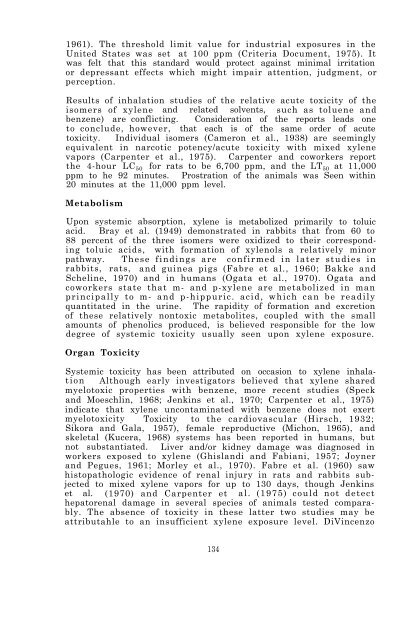Review of Inhalants - ARCHIVES - National Institute on Drug Abuse
Review of Inhalants - ARCHIVES - National Institute on Drug Abuse
Review of Inhalants - ARCHIVES - National Institute on Drug Abuse
You also want an ePaper? Increase the reach of your titles
YUMPU automatically turns print PDFs into web optimized ePapers that Google loves.
1961). The threshold limit value for industrial exposures in the<br />
United States was set at 100 ppm (Criteria Document, 1975). It<br />
was felt that this standard would protect against minimal irritati<strong>on</strong><br />
or depressant effects which might impair attenti<strong>on</strong>, judgment, or<br />
percepti<strong>on</strong>.<br />
Results <str<strong>on</strong>g>of</str<strong>on</strong>g> inhalati<strong>on</strong> studies <str<strong>on</strong>g>of</str<strong>on</strong>g> the relative acute toxicity <str<strong>on</strong>g>of</str<strong>on</strong>g> the<br />
isomers <str<strong>on</strong>g>of</str<strong>on</strong>g> xylene and related solvents, such as toluene and<br />
benzene) are c<strong>on</strong>flicting. C<strong>on</strong>siderati<strong>on</strong> <str<strong>on</strong>g>of</str<strong>on</strong>g> the reports leads <strong>on</strong>e<br />
to c<strong>on</strong>clude, however, that each is <str<strong>on</strong>g>of</str<strong>on</strong>g> the same order <str<strong>on</strong>g>of</str<strong>on</strong>g> acute<br />
toxicity. Individual isomers (Camer<strong>on</strong> et al., 1938) are seemingly<br />
equivalent in narcotic potency/acute toxicity with mixed xylene<br />
vapors (Carpenter et al., 1975). Carpenter and coworkers report<br />
the 4-hour LC 50 for rats to be 6,700 ppm, and the LT 50 at 11,000<br />
ppm to he 92 minutes. Prostrati<strong>on</strong> <str<strong>on</strong>g>of</str<strong>on</strong>g> the animals was Seen within<br />
20 minutes at the 11,000 ppm level.<br />
Metabolism<br />
Up<strong>on</strong> systemic absorpti<strong>on</strong>, xylene is metabolized primarily to toluic<br />
acid. Bray et al. (1949) dem<strong>on</strong>strated in rabbits that from 60 to<br />
88 percent <str<strong>on</strong>g>of</str<strong>on</strong>g> the three isomers were oxidized to their corresp<strong>on</strong>ding<br />
toluic acids, with formati<strong>on</strong> <str<strong>on</strong>g>of</str<strong>on</strong>g> xylenols a relatively minor<br />
pathway. These findings are c<strong>on</strong>firmed in later studies in<br />
rabbits, rats, and guinea pigs (Fabre et al., 1960; Bakke and<br />
Scheline, 1970) and in humans (Ogata et al., 1970). Ogata and<br />
coworkers state that m- and p-xylene are metabolized in man<br />
principally to m- and p-hippuric. acid, which can be readily<br />
quantitated in the urine. The rapidity <str<strong>on</strong>g>of</str<strong>on</strong>g> formati<strong>on</strong> and excreti<strong>on</strong><br />
<str<strong>on</strong>g>of</str<strong>on</strong>g> these relatively n<strong>on</strong>toxic metabolites, coupled with the small<br />
amounts <str<strong>on</strong>g>of</str<strong>on</strong>g> phenolics produced, is believed resp<strong>on</strong>sible for the low<br />
degree <str<strong>on</strong>g>of</str<strong>on</strong>g> systemic toxicity usually seen up<strong>on</strong> xylene exposure.<br />
Organ Toxicity<br />
Systemic toxicity has been attributed <strong>on</strong> occasi<strong>on</strong> to xylene inhalati<strong>on</strong><br />
Although early investigators believed that xylene shared<br />
myelotoxic properties with benzene, more recent studies (Speck<br />
and Moeschlin, 1968; Jenkins et al., 1970; Carpenter et al., 1975)<br />
indicate that xylene unc<strong>on</strong>taminated with benzene does not exert<br />
myelotoxicity Toxicity to the cardiovascular (Hirsch, 1932;<br />
Sikora and Gala, 1957), female reproductive (Mich<strong>on</strong>, 1965), and<br />
skeletal (Kucera, 1968) systems has been reported in humans, but<br />
not substantiated. Liver and/or kidney damage was diagnosed in<br />
workers exposed to xylene (Ghislandi and Fabiani, 1957; Joyner<br />
and Pegues, 1961; Morley et al., 1970). Fabre et al. (1960) saw<br />
histopathologic evidence <str<strong>on</strong>g>of</str<strong>on</strong>g> renal injury in rats and rabbits subjected<br />
to mixed xylene vapors for up to 130 days, though Jenkins<br />
et al. (1970) and Carpenter et al. (1975) could not detect<br />
hepatorenal damage in several species <str<strong>on</strong>g>of</str<strong>on</strong>g> animals tested comparably.<br />
The absence <str<strong>on</strong>g>of</str<strong>on</strong>g> toxicity in these latter two studies may be<br />
attributahle to an insufficient xylene exposure level. DiVincenzo<br />
134
















